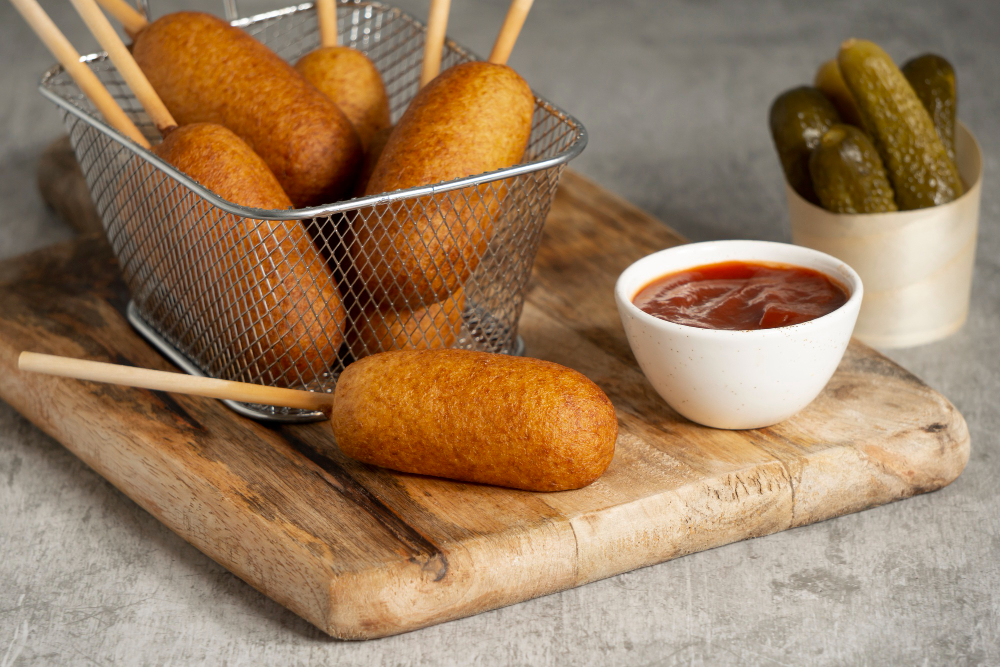Corn dogs have long captured the hearts of food enthusiasts in both Korea and America. As these two distinctive styles continue to grow in popularity, understanding the nutritional aspects has become increasingly important. In this article, we’ll be comparing Korean corn dog vs American corn dog nutrition, delving into the ingredients and preparation methods that set these two versions apart. By incorporating a comprehensive analysis of Korean vs American corn dog nutrition, we aim to provide readers with a better understanding of the health implications of their favorite snack.
The Global Appeal of Corn Dogs: The Corn Dog’s International Journey
While the corn dog has its roots in the United States, its irresistible taste and convenience have led to its widespread popularity around the world. This global appeal is evident in the fusion of local flavors and ingredients with the classic American recipe. The Korean corn dog is a prime example of how this portable snack has been adapted to cater to regional tastes while maintaining its core characteristics.
Cultural Adaptations: More Than Just a Snack
The success of the corn dog in both Korea and America highlights the adaptability and versatility of this simple yet delicious treat. As the snack continues to grow in popularity, it has become more than just a food item—it has turned into a cultural symbol, representing the power of culinary innovation and the blending of distinct food cultures. The Korean corn dog, in particular, showcases the creative spirit of Korean street food vendors and their ability to transform a classic American snack into a unique fusion experience.
What Sets Korean and American Corn Dogs Apart
The traditional American corn dog is a delightful treat that has stood the test of time. At its core, the American corn dog features a sausage, typically made from a blend of meats like beef and pork, or even an all-beef variant. The sausage is then coated in a thick, sweet cornmeal batter, providing the perfect contrast of flavors and textures. Once dipped, the corn dog is deep-fried to achieve a crispy, golden-brown exterior that complements the juicy, savory sausage inside. The American corn dog has inspired a range of variations, including different types of sausages, batter modifications, and unique dipping sauces to cater to diverse tastes.
Korean corn dogs, or “gamja hotdogs,” as they’re locally known, offer a spin on the American classic. These corn dogs often feature a combination of sausage and cheese, creating an ooey-gooey, irresistible center. The batter is typically lighter than its American counterpart, and the final product is often rolled in sugar or panko breadcrumbs for extra crunch. Korean corn dogs are also known for their creative toppings, such as spicy gochujang sauce, honey mustard, or even crushed ramen noodles.
Nutritional Breakdown of Korean and American Corn Dogs
To better understand the nutritional differences between Korean and American corn dogs, we’ll present a side-by-side comparison of the key nutritional elements, including calories, fats, protein, and carbohydrates.

American Corn Dogs
- Calories: 250 kCal
- Fat: 12g
- Protein: 9g
- Carbohydrates: 27g
Korean Corn Dog (Wang Korea Mozzarella Cheese & Frish Sausage Corn-Dog – Per 100g):
- Calories: 287.5 kCal
- Fat: 22.5g
- Protein: 8.75g
- Carbohydrates: 11.25g
The Health Implications
The comparison reveals that Korean corn dogs tend to be higher in calories, fat, and carbohydrates than their American counterparts, largely due to the addition of cheese and sugar. While both styles of corn dogs are indulgent snacks, those seeking a lower-calorie option may prefer the classic American version. However, it’s important to note that neither option is a health food, and moderation should always be practiced when enjoying these treats.
Are All Corn Dogs Created Equal? Customizing Your Corn Dog Experience
For those looking to enjoy corn dogs with a slightly healthier twist, there are several alternative options and ingredient swaps to consider. Baked corn dogs, rather than deep-fried, can significantly reduce the fat content. Additionally, using whole-grain or gluten-free batter can cater to dietary preferences and restrictions. Experimenting with plant-based sausages or cheese alternatives can also make corn dogs more suitable for vegetarian or vegan diets.
Making Informed Choices
Consumers can make more informed choices about corn dogs based on their nutritional preferences or dietary restrictions by researching the ingredients and preparation methods used by different vendors. Many eateries and food trucks now offer a variety of corn dog options, catering to a wide range of dietary needs and tastes.
Popular Corn Dog Destinations
Here are a few popular eateries and food trucks that offer an assortment of corn dog options:
- Seoul Hotdog: A popular Korean street food vendor offering traditional Korean corn dogs with various fillings and toppings to choose from.
- Fletcher’s Original State Fair Corny Dogs: Known for their classic American corn dogs, Fletcher’s has been serving up this iconic treat at the Texas State Fair since 1942.
- Dog Haus: A gourmet hot dog chain with locations across the United States, Dog Haus offers a diverse menu, including a range of corn dogs made with premium sausages and unique batters.
Conclusion
In conclusion, while both Korean and American corn dogs offer a delicious and indulgent treat, they differ significantly in terms of ingredients, preparation, and nutritional content. Consumers should be aware of these differences when deciding which style to indulge in and remember to enjoy these snacks in moderation. With a growing number of eateries and food trucks offering diverse corn dog options, there’s never been a better time to explore and experiment with different styles of corn dogs. Don’t be afraid to try new variations and share your experiences with fellow food enthusiasts. Happy snacking!

